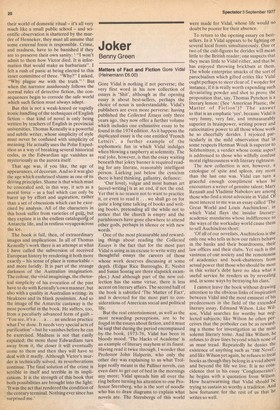Burning down
Peter Ackroyd
A Victim of the Aurora Thomas Keneally (Collins 24.50) Although the publishers describe this remarkable novel as 'Thomas Keneally's first detective story', it effectively marks the demise of that debased and flatulent genre. The villain, after all, is 'the aurora' itself and the victim is never specified; it might even turn out to be the novel itself. It is set at the close of the sticky Edwardian era and so, theoretically, it might be described just as easily as an historical novel — but, like all of Keneally's work it actually subverts European history (Keneally is an Australian writer, and this plays a large though unacknowledged role in his writing) by bringing to it alien and more vigorous perceptions. A group of Edwardians are travelling to the Antarctic on the New British South Polar Expedition; the King dies when they are isolated on the ice, and so in a sense they become the last Edwardians on earth, per' sisting in rituals which have already become outmoded. In Keneally's hands the historical novel is redeemed as the raw materials of the past are turned into a kind of fable.
These blinding metaphysical matters don't mean that Keneally is forgetful of technical considerations. He astutely aligns the imaginative content of historical fiction with the pert structure of the detective thriller, and by conflating them creates a new thing. Victor Henneker, a homosexual journalist who is reporting on the Expedition, is brutually murdered and left on the ice —and the narrator sets out to uncover the identity of the murderer. A conventional detective thriller would, at this point, assume that murder is as much part of the orderly business of life as cooking or making the bed: it has to be assumed that murders are rational, because they are always solved by the use of reason. Crime has its cultural codes and conventions and, it they were ever to be broken, it would be difficult to know what 'crime' actually was. An act becomes a 'murder' only when it fits neatly into an ordered scale of human behaviour. But nothing is ordered at the Pole: these rather prim Edwardian gentlemen are surrounded by packs of ice whose natural processes remain mysterious to them, above their heads gleams the aurora itself which defies their powers of observation and description, they discover a sodomite among them, and then they learn that they are being watched by a castaway from an earlier expedition who has abandoned human habitation but who invades their lives like some inescapable wraith. They • are, in other words, marooned; and when their world of domestic ritual — it's all very much like a small public school — and scientific observation is shattered by the murder of Henneker, they must all assume that some external force is responsible. Crime, and madness, have to be banished if they are to preserve their own sanity: "I won't admit to them how Victor died. It is information that would make us barbarians". I felt a rush of panic at being elected to this inner committee of three. "Why?" I asked, "Why plague me with the truth."' But when the narrator assiduously follows the normal rules of detective fiction, the consequences begin to corrode the safe world which such fiction must always adopt.
But this is not a weak-kneed or vapidly ironic handling of the techniques of English fiction — that kind of novel is only being written by teachers of English in provincial universities. Thomas Keneally is a powerful and subtle writer, whose simplicity of style must never be confused with simplicity of meaning. He actually uses the Polar Expedition as a way of breaking several historical codes, as the Edwardian age vanishes as mysteriously as the aurora itself.
That age was, if you like, the age of appearances, of decorum. And so it was ajso the age which enshrined shame as one of its driving principles. Shame is that which must be concealed and, in this way, it acts as a moral force — as a fuel which can only be burnt up by effort and aspiration, rather than a set of obsessions which can be exorcised by analysis. All of the characters in this book suffer from varieties of guilt, but they expiate it in the endless cataloguing of Antarctic life, and in restless voyages-across the ice.
The book is full, then, of extraordinary images and implications. In all of Thomas Keneally's work there is an attempt at what I have called the subversion of received European history by rendering it both more exactly — his sense of place is remarkable — and more luridly. It is part of the strange darkness of the Australian imagination. The colour, the vivid imaginings, the rhetorical simplicity of his evocation of the past have to do with Keneally's own manner, but also with a quality in Australian writings its bleakness and its blank pessimism. And so the image of the Antarctic castaway is the most powerful in the book. He suffers, too, from a peculiarly advanced form of guilt — 'You see, it's a . a . . an unclean practice what I've done. It needs very special acts of purification' but he vanishes before he can be exorcised. Madness is not that easily expiated; the more these Edwardians turn away from it, the closer it will eventually come to them and then they will have to deal with it madly. Although Victor's murder is technically solved, its reverberations continue. The final solution of the crime is terrible in itself and terrible in its implications. It is the strength of this book that both possibilities are brought into the light: 'It was the act that rendered the condition of the century terminal. Nothing ever since has surprised me.'































 Previous page
Previous page